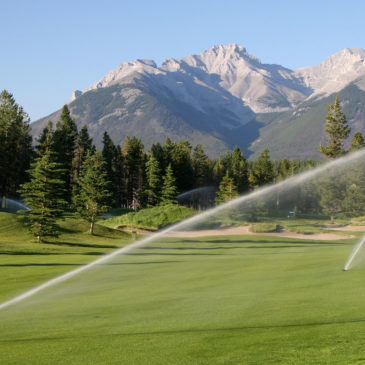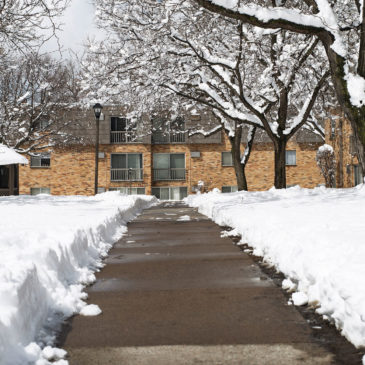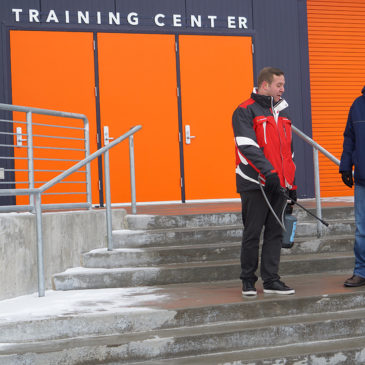Each year, environmentally friendly ice melt products claim a larger percentage of the ice melt and de-ice market. A variety of products claim to be environmentally friendly, and some of them have found particular success in the consumer market where environmentally conscious homeowners with children, pets or gardens often are willing to pay a little more for a safer product.
In the commercial snow and ice removal business, the demand for environmentally friendly products also is growing – enough so that many products lay claim to the green label with some pretty creative logic — e.g., chloride-based products are safe because they are “naturally occurring elements;” salt mining is “safer for the environment” than other forms of mining; the transportation of bulk materials by barge minimizes emissions versus transportation by truck).
The fact is, however, that most chloride-based products cause some form of harm to humans, pets, plants and aquatic life. Sodium chloride products, or rock salt, cause irritation and burns to the skin and eyes and, if swallowed, to the mouth, throat, and digestive tract. The products’ deleterious effects are true for dogs, too.
Calcium chloride-based products can burn human skin when contacted. If inhaled, dust particles can cause severe irritation. If ingested, they can cause severe irritation and bouts of vomiting and diarrhea. They irritate dogs’ paws and, worse, are poisonous to canines. When spread into gardens and onto vegetation, calcium chloride products can have a defoliating effect on trees and other plants.
Magnesium chloride-based products are considered better for the environment than those made from sodium and calcium chloride, but they cannot be considered child and pet friendly ice melts. All three chloride-based products are hygroscopic. They absorb moisture from the air, and they pull moisture from hands, skin and vegetation.
Finally, if chloride-based products leach into waterways, they reduce the water’s available oxygen levels, leading to the death of aquatic life.
Beyond health and environmental concerns, chlorides also are corrosive to metals and, in varying degrees, to concrete, asphalt and stone walkways, and they will reduce the functional life of structures, such as railings and doors.
Liquid de-icers are a new alternative to chloride-based ice melt products. One such product based upon formic technology is 100 percent chloride free and is readily biodegradable. It is safer for pets, plants, metal, concrete and other surfaces. In fact, its toxicity LD-50 oral rate is 81 percent lower than calcium chloride and approximately 46 percent lower than calcium magnesium acetate, rock salt and potassium acetate.
Ice and snow removal contractors have been attracted to liquid ice melt and de-ice products in recent years largely because these products are much easier to apply. There is no need to lug a bag of granular product across walkways and up and down stairways to apply and no need to continually dip a gloved hand or a scoop into the bag. Spray applications are far more efficient and easy to use, and they provide for very precise application rates.
For many maintenance and engineering managers, consumer concerns about child and pet-based eco-friendliness are viewed as of secondary importance. After all, children and pets typically are not traversing or playing on the grounds of office buildings and office parks. But an office’s indoor environment can be negatively impacted by some ice melt and de-ice materials.
When tracked into a facility, sodium chloride de-icers leave a white residue that can dull the finish of floors and fade the color of carpets. Calcium and magnesium chloride-based products coat floors with an oily, slippery residue that damages wax and urethane finishes, posing a safety risk to employees and visitors.
By contrast, the neutral pH formulations of formic technology de-icers eliminate tracking and leave virtually no residue. This reduces near-term labor costs associated with manual cleaning and provides for a safer environment.
Outdoors, formic technology de-icers create a safer environment more quickly than chloride-based de-icers. For example, some formic technology de-icers have a speed of melt of about 30-50 seconds by reducing the freezing point to temperatures as low as minus 63 degrees. These de-icers remove thin layers of ice and prevent new snow and ice from accumulating. By contrast, chloride-based granular de-icers take a minimum of 3-5 minutes – and as much as 10 minutes — to achieve an acceptable melt.
Most users will achieve a lower application cost per 1,000 square feet with liquids than with granular de-icers because of the ease and speed of application and the reduced amount of product needed to produce an acceptable melt.
Facilities maintenance personnel are finding that the benefits of liquid de-icers based upon formic technology – environmental friendliness, no damage to carpets and floors indoors or to surfaces outdoors, safer environments indoors and out, and cost-efficiency – make it easier for them to create a clean, safe environment.



